The Begonia Maculata is a vibrant favourite at Prickle. Directly translating to 'spotted' in Italian, this tropical beauty is renowned for green leaves with purple undersides and eye-catching white dots.
Happy in its native habitat of Southeast Brazil, the key to keeping it comfortable at home is replicating the bright indirect light and humid conditions of a lush tropical rainforest.
Polka dot plants are average growers, low maintenance, and start off in compact sizes of around 30cm. The only catch is that they're not safe for pets and curious toddlers who might take a nibble! If that's not a concern, read our full polka dot plant care guide below to learn more about how to be a plant parent to this iconic prickle.
The Polka Dot Plant
Not to be confused with the Hypoestes Phyllostachya 'Freckle Face', the Begonia Maculata Polka Dot Plant is also a houseplant that cannot be grown outdoors in the UK. This prickle is a homebody through and through. Here are the basic facts you need to know.
Other names: Begonia Maculata (Polka Dot); Begonia Maculata; Polka Dot Plant
Native to: Brazil, South America
-
Light: Bright, indirect light
-
Water: Water every week or two
-
Environment: Occasional mist
-
Best location: Bathroom, living room, office
-
Minimum temperature: 18°C
-
Pet friendly: No
-
Propagation: Water propagation
Polka Dot Begonia
Cassie Pot
How to Look After a Polka Dot Plant Indoors
Polka dot plant care is blissfully easy - that's why this prickle is part of our low-maintenance collection.
Light and Temperatures
Keep polka-dot plants in bright, indirect sunlight. They can handle a little shade but avoid any darkly shaded corners. Likewise, prolonged exposure to direct sunlight or artificial light can burn the leaves. A temperature range between 18℃ and 30℃ will provide the best results.
The polka dot plant outdoors in the rainforest is accustomed to bright light filtering through the rainforest canopy, so that's what you should try to recreate!
Polka Dot Plants Humidity
While most tropical plants prefer high humidity, the green and purplish leaves of polka-dot plants can be a bit fussy. Give it a mist every few days, and keep an eye on the foliage. If its vitality starts to fade, lack of humidity or too much sunlight are typically the culprits.
How Often to Water a Polka Dot Plant
Water your polka dot plant every week or two, ideally when the soil starts to dry. You want to aim for moist soil rather than drenched! The water requirements of all houseplants depend on the conditions of your home - hotter and drier homes can dehydrate plants faster. You might also need to water your polka dot plant more in the spring and summer too, when the indirect light is brighter and lasts longer throughout the day.
Notice that the leaves have gone brown or soggy? Lay off watering your polka dot plant for a little while; it’s being overwatered.
Avoid Root Rot
The polka dot plant grows with very thin roots, making it particularly susceptible to root rot if the soil is too wet. Dig your finger into the soil and if the top 5cm are still damp, it doesn't need watering yet. Only when the soil feels dry does it need a drink? Likewise, make sure this prickle and any other you are nurturing are planted in pots with good drainage.
How to Prune a Leggy Polka Dot Plant
Polka dot plants are pruned in the winter. Even though they aren't outdoor plants, the polka dot plant is typically dormant during the colder months indoors, so this is the perfect time to make a few snips!
Cut back any leggy, dead or brown leaves with clean, sterilised scissors near a node on the stem. This will prevent the plant from dying over winter and even encourage new leaves in the spring for bushier growth.
To prune for better growth even when you have no brown leaves, cut a few healthy stems just above the nodes. New growth should emerge from those nodes to create a rounder, bushy shape.
Polka Dot Plant Propagation
Using the water method during the growing season is best for polka dot plant propagation.
-
Choose a mature, healthy stem and cut approximately 5cm below the leaf at an angle.
-
Place the clipping in water at room temperature and keep it in a warm place.
-
Once roots emerge from the clipping, transport it to a nursery pot with a loose houseplant potting mix.
You don't need to use peat moss or rooting hormone to propagate polka dot plants, just ensure any new plants get the right amount of indirect light, humidity and water. If it grows leggy, regular pinching or pruning off stems can encourage a fuller shape. It's a very simple process, so even new gardeners can propagate and master polka dot plant care.
Fertilising Polka Dot Plants
Polka dot plants benefit from a little fertiliser once a month or every few weeks, but only during the growing season. Too much fertiliser can damage the thin roots, so use half strength and increase gradually until the foliage is strong and slightly waxy. Once the full sun starts to shine in late summer, put the fertiliser away until next spring.
When they are happy and fully established, polka dot plants may produce clusters of white and pink flowers in the spring and summer. Take extra good care of your polka dot plant and it may even reach heights of 1.5 metres!
Pests and Diseases
The last part of our polka dot plant indoor care guide is avoiding typical diseases and pests.
Too much humidity can lead to powdery mildew, which appears as white powder on the leaves and stems. Avoid powdery mildew by only misting on the stems and base of the plant. Cure it by removing infected leaves and treating the plant with an anti-fungal solution. Baking soda is a popular choice!
Mealybugs and scale insects may also attack an unhealthy polka dot plant, causing yellow leaves and eventual plant death. Mealybugs look like tiny cotton puffs on the undersides of leaves - they may look similar to the spots on the top of polka-dot plant leaves, so don't be fooled. Scale insects, on the other hand, are very hard-shelled insects that can appear all over the leaves and stems. Remove these insects manually and use an insecticide, like neem oil, to treat it. Don't forget to check the larger lower leaves, where pest species are harder to spot!
Polka Dot Plants Care with Prickle
Who needs year-round flowers when you have the vibrant green and pink-purple leaves of the polka dot plant?! If you need help encouraging new growth, troubleshooting polka dot plant care, or just preparing to become a plant parent, reach out. Follow us on social media @prickplantsuk and email us at contact@prickleplants.co.uk for extra advice.
P.S. If you want to find a polka dot-like plant that's suitable for pets and children, then check out our Lil' Polka Dot Plant. With marbled white leaves, Hypoestes Phyllostachya is a totally different plant species that is perfect for the bathroom and has air-purifying properties, too.




